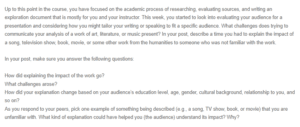Considering Your Audience
Sometimes it’s difficult for people to understand the deep meaning of the artwork. Art instills values and translates experiences across different times and spaces. It also has aesthetic value and changes people’s opinions. I once explained artwork to an audience, and it went well. It made people thrilled to know the deeper meaning of the art. They learned how not just to see artwork but also to look at it and think about its message. Most people embraced art, its message, and its beauty (Fiske, 1999). They understood how art is received and made. However, I faced some challenges. Some people did not want to think and internalize the artwork to understand the message in it. Making people who already have a negative opinion about art understand it is challenging. It’s difficult for some people to appreciate art no matter how much time is taken to understand its message and beauty.
During the explanations and teaching people about art, I changed the way of communication depending on my audience. When explaining to young people in high school and below, I used stories to capture their attention (Baxter & Braverman, 2004). The young girls and boys enjoyed the stories relating to art; hence connecting the story and the art was easy. With adult and educated audiences, I directly explained the artwork, its message, and its impact on society. With my female audience, I concentrated on the message and the aesthetic value of the artwork. I allowed different people from different cultural backgrounds and cultures the effect they feel art has on them. I then took time to explain the impact that artwork has on society regardless of culture and race. I showed them how art unites cultures, races, and nations of the world.
References
Fiske, E. B. (Ed.). (1999). Champions of change: The impact of the arts on learning. Arts Education Partnership.
Baxter, L. W., & Braverman, M. T. (2004). Communicating results to different audiences. Foundations and Evaluation: Contexts and practices for effective philanthropy. San Francisco: Jossey-Bass.
ORDER A PLAGIARISM-FREE PAPER HERE
We’ll write everything from scratch
Question

Considering Your Audience
Up to this point in the course, you have focused on the academic process of researching, evaluating sources, and writing an exploration document that is mostly for you and your instructor. This week, you looked into evaluating your audience for a presentation and considering how you might tailor your writing or speaking to fit a specific audience. What challenges does trying to communicate your analysis of a work of art, literature, or music present? In your post, describe a time you had to explain the impact of a song, television show, book, movie, or some other work from the humanities to someone who was not familiar with the work.
In your post, make sure you answer the following questions:
How did explaining the impact of the work go?
What challenges arose?
How did your explanation change based on your audience’s education level, age, gender, cultural background, relationship with you, and so on?
As you respond to your peers, pick one example of something being described (e.g., a song, TV show, book, or movie) that you are unfamiliar with. What kind of explanation could have helped you (the audience) understand its impact? Why?

